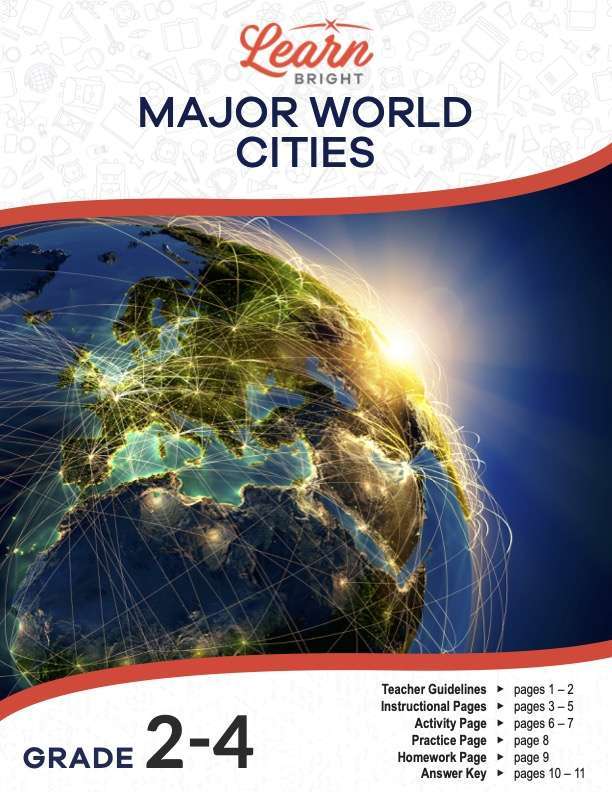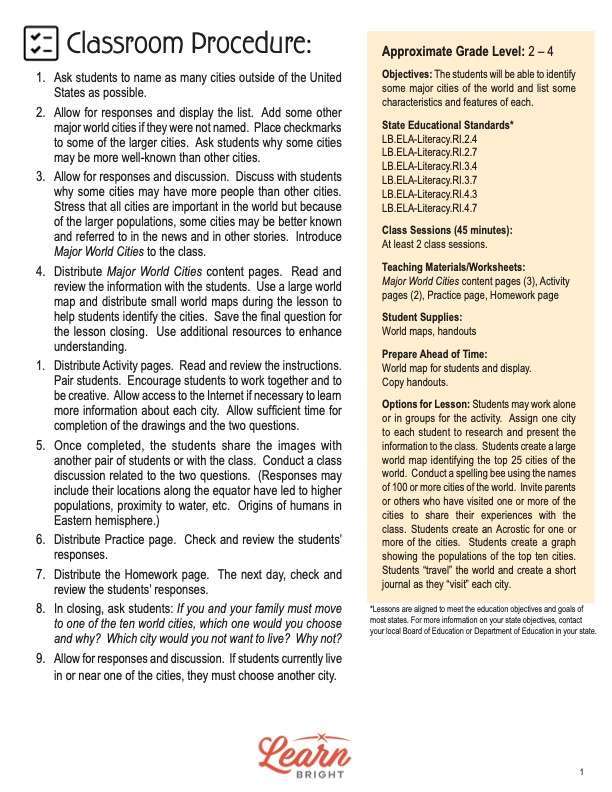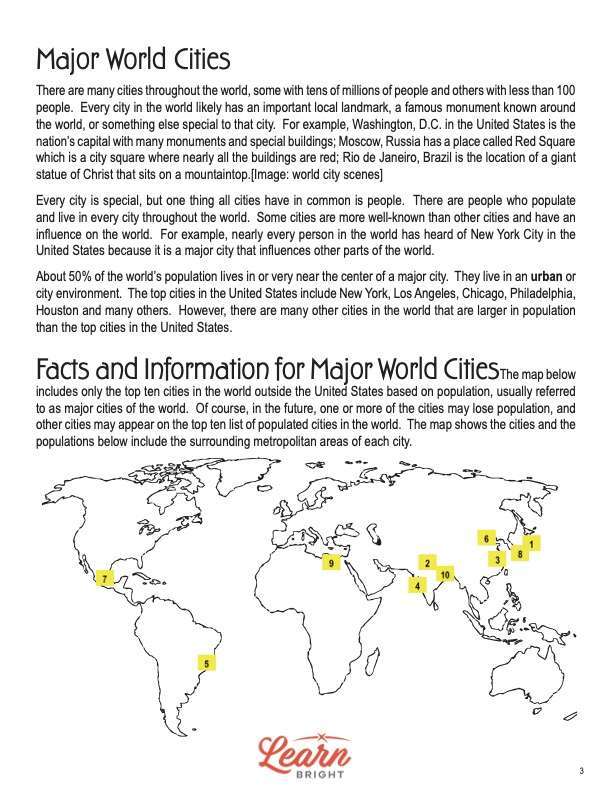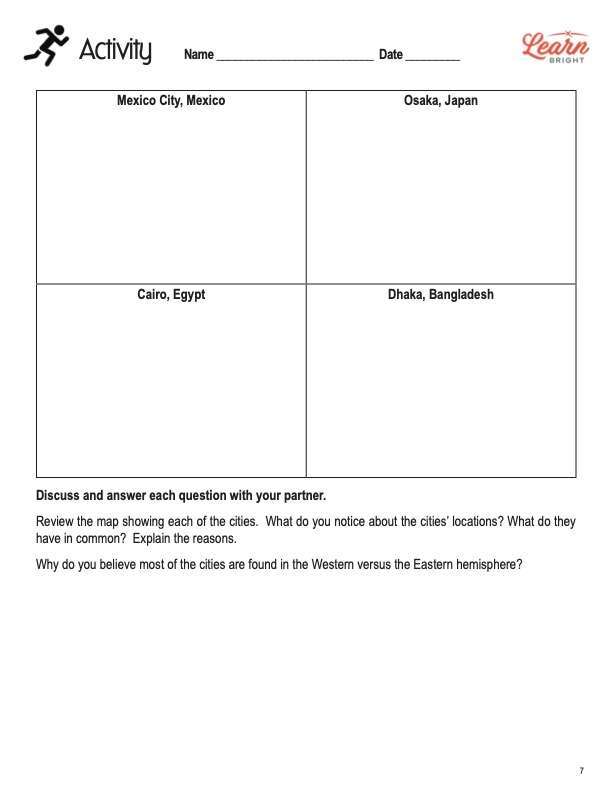Description
What our Major World Cities lesson plan includes
Lesson Objective and Overview: Major World Cities explains some of the traits and features of major cities around the world. These cities are the ones with the highest population counts. Students will learn about cities like Tokyo, Mumbai, Mexico City, and Cairo. The lesson focuses on the top 10 most populated cities primarily. However, it also touches on other major cities like London, Paris, and Moscow. This lesson is for students in 2nd grade, 3rd grade, and 4th grade.
Classroom Procedure
Every lesson plan provides you with a classroom procedure page that outlines a step-by-step guide to follow. You do not have to follow the guide exactly. The guide helps you organize the lesson and details when to hand out worksheets. It also lists information in the yellow box that you might find useful. You will find the lesson objectives, state standards, and number of class sessions the lesson should take to complete in this area. In addition, it describes the supplies you will need as well as what and how you need to prepare beforehand. This lesson requires world maps for display
Options for Lesson
You can check out the “Options for Lesson” section of the classroom procedure page for additional suggestions for ideas and activities to incorporate into the lesson. Students may work alone or in groups for the activity. Assign one city to each student to research and present the information to the class. Students create a large world map identifying the top 25 cities of the world. Conduct a spelling bee using the names of 100 or more cities of the world. Invite parents or others who have visited one or more of the cities to share their experiences with the class. Students create an acrostic poem for one or more of the cities. Have students create a graph showing the populations of the top ten cities. Students “travel” the world and create a short journal as they “visit” each city.
Teacher Notes
The teacher notes page provides an extra paragraph of information to help guide the lesson. It mentions that while students may know the names of many of these cities, they may not know much about them. You can use the blank lines to write down any other ideas or thoughts you have about the topic as you prepare.
MAJOR WORLD CITIES LESSON PLAN CONTENT PAGES
Introduction
The Major World Cities lesson plan contains three content pages. There are many cities throughout the world. Some have millions of people and others with less than 100 people. Every city in the world likely has an important local landmark, a famous monument people around the world would know, or something else special to that city.
For example, Washington, DC, in the United States is the nation’s capital with many monuments and special buildings. Moscow, Russia, has a place called Red Square, which is a city square where nearly all the buildings are red. In Brazil, Rio de Janeiro is the location of a giant statue of Christ that sits on a mountaintop.
Every city is special, but one thing all cities have in common is people. There are people who populate and live in every city throughout the world. Some cities are more well known than other cities and even have an influence on the world. For example, nearly every person in the world has heard of New York City in the United States because it is a major city that influences other parts of the world.
Major Cities of the World
About 50% of the world’s population lives in or very near the center of a major city, in an urban or city environment. The top cities in the United States include New York, Los Angeles, Chicago, Philadelphia, Houston, and many others. However, there are many other cities in the world that are much larger in population than the top cities in the United States.
A map on the first content page marks the top 10 cities in the world based on population. We usually refer to these as major cities of the world. Of course, in the future, one or more of the cities may lose population, and other cities may grow enough to make the top 10 list. The populations listed next to each city are rounded to the nearest thousand.
Tokyo, the capital of Japan, is the most populous city in the world, with over 37 million residents. Stone age tribes once inhabited this modern city. Delhi, India, is next with just over 32 million people. The city dates back to the 1st century BC and is the political center of the country.
Also on the list is Mexico City, which is built on the ruins of the ancient Aztec civilization. Another city is Cairo, with almost 22 million people. Cairo is a port on the Nile River and is home to famous mosques and palaces. It is also the largest city in the Middle East and Africa.
Other Major World Cities
There are many other major cities throughout the world including smaller cities such as the following:
- London, England: a financial center of the world; dominate fields in finance, media, law, advertising, and technology; tourism attracts millions of people each year
- Paris, France: top city for fashion, tourism, and a strong base of multi-million-dollar companies; home to the Eiffel Tower and other historical landmarks
- Singapore: a city and country in Asia; still the global financial hub of Asia-Pacific and Asian trade despite small population
- Moscow, Russia: financial, political, and economic center of Russia; influences politics throughout the world; base of Russia’s politicians and home of the Kremlin
- Lagos, Nigeria: largest population on the entire African continent; economic center of Africa
- Riyadh, Saudi Arabia: population of just 7 million, has influence over many of the Middle Eastern countries; contains two of Islam’s holiest sites
In addition to the above cities, the cities in the United States that have influenced the world as well include New York, Los Angeles, Chicago, and many others. The major cities of the world have influenced societies throughout history. They will continue to be influential in economics, politics, and many other aspects involving the nearly 8 billion people of the world.
MAJOR WORLD CITIES LESSON PLAN WORKSHEETS
The Major World Cities lesson plan includes three worksheets: an activity worksheet, a practice worksheet, and a homework assignment. Each one will help students solidify their grasp of the material they learned throughout the lesson. You can refer to the classroom procedure guidelines to know when to hand out each worksheet.
DRAW THE SYMBOL ACTIVITY
Students will work with partners for the activity worksheet. They will draw an image that represents each of the 10 major cities that they learned about. Then they will discuss and answer a few questions at the bottom of the second page.
MATCH THE CITIES PRACTICE WORKSHEET
There are two sections on the practice worksheet. The first requires students to rank the cities in order of population from most to least. The second section requires students to match the cities to facts. They will use the letters next to the cities in the first section to mark the facts they represent.
MAJOR WORLD CITIES HOMEWORK ASSIGNMENT
Similar to the practice worksheet, the homework has two parts. The first part requires students to answer a series of 15 questions about what they learned in the lesson. The second part requires them to write the country of each major city they learned about. This section also includes some of the less populated cities. There are 16 cities in this section.
Worksheet Answer Keys
There are answer keys for both the practice and homework worksheets in the lesson plan document. Correct answers are in red to make it easy to compare them with your students’ work. If you choose to administer the lesson pages to your students via PDF, you will need to save a new file that omits these pages. Otherwise, you can simply print out the applicable pages and keep these as reference for yourself when grading assignments.









